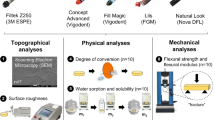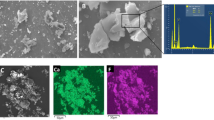Abstract
The cementum–enamel junction (CEJ) is a unique interface that plays a critical role in effectively transferring force from the top of the tooth to the jawbone. A comparative study of bovine and equine teeth has been carried out experimentally to establish the relationship among the interfacial structure, fracture resistance, and mechanical functions. The CEJs were analyzed by optical microscopy and scanning electron microscopy (SEM). Microhardness and elastic modulus were measured with a Vickers microhardness tester and a nanoindentation system. A modified cantilever beam technique was used to study CEJ fracture process and the toughness (Gc). It was observed that CEJ is a distinct interface connecting the hard enamel (200–350 kg/mm2) with the soft cementum (∼20–30 kg/mm2). Bovine CEJ was macroscopically flat and smooth. However, under SEM, a close integration of cementum bumps and enamel pits at the 5 μm level and dimples at the 200 nm level were clearly seen. In equine CEJ, the similar flat cementum–enamel interface was interrupted by hemispherical cementum protrusions (average size of 28.3 μm) at high density (340/mm2). Despite the microscopic roughness, bovine CEJ was easy to fracture at relatively low toughness (128 J/m2). The measured toughness for equine CEJ was about seven times that of bovine (1140 J/m2). The high toughness has been attributed to the mechanical interlocking provided by the cementum protrusions. The underlying crack bridging mechanism and the applications to the design of orthopaedic implants are briefly discussed.
Similar content being viewed by others
References
A.G. Evans, D.R. Mumm, J.W. Hutchinson, G.H. Meier, F.S. Pettit: Mechanisms controlling the durability of thermal-barrier coatings. Prog. Mater. Sci. 46, 505 (2001).
R. Wang, C. Mercer, A.G. Evans, C.V. Cooper, H.K. Yoon: Delamination and spalling of diamond-like-carbon tribological surfaces. Diamond Relat. Mater. 11, 1797 (2002).
R.J. Furlong, J.F. Osborn: Fixation of hip protheses by hydroxyapatite ceramic coatings. J. Bone Joint Surg. 73B, 741 (1991).
J.A.M Clemens, J.G.C Wolke, C.P.A.T Klein, K. de Groot: Fatigue behavior of calcium phosphate coatings with different stability under dry and wet conditions. J. Biomed. Mater. Res. 48, 741 (1999).
W.L. Jaffe, D.F. Scott: Total hip arthroplasty with hydroxyapatite-coated prostheses. J. Bone Joint Surg. 78A, 1918 (1996).
V. Imbeni, J.J. Kruzic, G.W. Marshall, S.J. Marshall, R.O. Ritchie: The dentin-enamel junction and the fracture of human teeth. Nat. Mater. 4, 229 (2005).
R.Z. Wang, S. Weiner: Strain-structure relations in human teeth using Moire fringes. J. Biomech. 31, 135 (1998).
S.N. White, M.L. Paine, W. Luo, M. Sarikaya, H. Fong, Z.K. Yu, Z.C. Li, M.L. Snead: The dentino-enamel junction is a broad transitional zone uniting dissimilar bioceramic composites. J. Am. Ceram. Soc. 83, 238 (2000).
S.P. Ho, M. Balooch, S.J. Marshall, G.W. Marshall: Local properties of a functionally graded interphase between cementum and dentin. J. Biomed. Mater. Res. 70A, 480 (2004).
S. Weiner, L. Addadi: Design strategies in mineralized biological materials. J. Mater. Chem. 7, 689 (1997).
A.R. Ten Cate: Oral Histology: Development, Structure, and Function 5th ed. (Mosby, St. Louis, MO, 1994), p. 218.
G.J. Baker, J. Easley: Equine Dentistry 1st ed. (W.B. Saunders, London, UK, 1999), pp. 3–28.
M.A. Listgarten: A light and electron microscopy study of coronal cementogenesis. Archs Oral Biol. 13, 93 (1968).
S.J. Jones, A. Boyde: Coronal cementogenesis in the horse. Archs Oral Biol. 19, 605 (1974).
K. de Groot, J.G.C Wolke, J.A. Jansen: Calcium phosphate coatings for medical implants. Proc Inst. Mech Eng. H. J. Eng. Med. 212, 137 (1998).
J.W. Xie, M.J. Baumann, L.R. McCabe: Osteoblasts respond to hydroxyapatite surfaces with immediate changes in gene expression. J. Biomed. Mater. Res. 71A, 108 (2004).
P.B. Mills, J.T. Irving: Coronal cementogenesis in cattle. Archs Oral Biol. 12, 929 (1967).
S. Kilic, P.M. Dixon, S.A. Kempson: A light microscopic and ultrastructural examination of calcified dental tissues of horses: 4. Cement and the amelocemental junction. Equine Vet. J. 29, 213 (1997).
J.W. Obreimoff: The splitting strength of mica. Proc. R. Soc. London, A 127, 290 (1930).
B. Lawn: Fracture of Brittle Solids 2nd ed. (Cambridge Univ. Press, Cambridge, UK, 1993), pp. 10, 11, 37.
A.G. Evans, E.A. Charles: Fracture toughness determinations by indentation. J. Am. Ceram. Soc. 59, 371 (1976).
J. Zhang, J.J. Lewandowski: Interfacial fracture-toughness measurement using indentation. J. Mater. Sci. 29, 4022 (1994).
V. Imbeni, J.J. Kruzic, G.W. Marshall, S.J. Marshall, R.O. Ritchie: The dentin-enamel junction and the fracture of human teeth. Nat. Mater. 4, 229 (2005).
R.D. Frandson: Anatomy and Physiology of Farm Animals 4th ed. (Lea & Febiger, Philadelphia, PA, 1986), pp. 309–335.
J.D. Bobyn, R.M. Pilliar, H.U. Cameron, G.C. Weatherly: The optimum pore size for the fixation of porous-surfaced metal implants by the ingrowth of bone. Clin. Orthop. Relat. Res. 150, 263 (1980).
T.P. Schmalzried, W.H. Harris: The Harris–Galante porous-coated acetabular component with screw fixation—Radiographic analysis of 83 primary hip replacements at a minimum of 5 years. J. Bone Joint Surg. Am. 74A, 1130 (1992).
J.D. Bobyn, G.J. Stackpool, S.A. Hacking, M. Tanzer, J.J. Krygier: Characteristics of bone ingrowth and interface mechanics of a new porous tantalum biomaterial. J. Bone Joint Surg. Brit. 81B, 907 (1999).
M.M. Bornstein, B. Schmid, U.C. Belser, A. Lussi, D. Buser: Early loading of non-submerged titanium implants with a sandblasted and acid-etched surface. Clin. Oral Implants Res. 16, 631 (2005).
R. Wang: Anisotropic fracture in bovine root and coronal dentin. Dent. Mater. 21, 429 (2005).
Author information
Authors and Affiliations
Corresponding author
Rights and permissions
About this article
Cite this article
Wang, R., Hu, Y. & Ng, C. Microstructure and interfacial fracture at the cementum-enamel junctions in equine and bovine teeth. Journal of Materials Research 21, 2146–2155 (2006). https://doi.org/10.1557/jmr.2006.0265
Received:
Accepted:
Published:
Issue Date:
DOI: https://doi.org/10.1557/jmr.2006.0265




